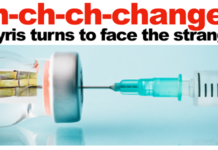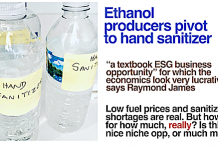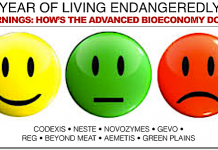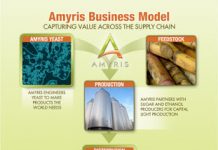Jim Lane
In California, Solazyme (SZYM) reported Q2 revenues of $11.7M compared with $15.9M in Q22014. GAAP net loss was $37.2 million for Q2 2015, compared to net loss of $42.9M in the prior year period.
The company said that “year over year decline in revenues was due to expected decreases in funded program revenue as well as in product revenue due to the timing of certain Algenist sales activities and slower than anticipated adoption rates for Encapso.” The market responded to the results by slashing the stock price 20 percent in Friday trading.
Analyst reaction was more positive, Raymond James analyst Pavel Molchanov describing the results as “Uneventful” while reiterating an Outperform rating, while Cowen & Co analyst Jeffrey Osborne referred to “Wrinkles In Revenue Performance,” while pointing to “Weak Drilling Market Disappoints”.
Osborne recapped the quarter” “Revenue for the quarter came in below expectations, management attributed this shortfall to lower than expected adoption rates of Encapso, the company’s drilling lubricant. New product introductions and manufacturing improvements at the Moema facility should translate to potential future gains.”
Piper Jaffray analyst Mike Ritzenthaler raised the product demand question again, writing: “We maintain our Underweight rating and $2 target on SZYM shares following light Q2 revenues and a suspension of forward guidance. Importantly, both product revenues and funded R&D declined y/y, while costs were essentially in-line.
“Despite modest progress toward an operational Moema, we are still not convinced that the company’s commercial markets are ready for commercial volumes anyway. The Clinton asset is apparently already capable of producing in-spec product and was essentially unused again in 2Q15. Progress toward sustainable operations at Moema may sound encouraging, but is meaningless to the company’s P&L without firm product demand. Ultimately, substantial demand improvement will be needed to get to cash flow break even, and we are unsure whether a novel product focused on drilling fluids in the current environment is the right strategy.
Molchanov countered: “The versatility of Solazyme’s algae-produced oils – which, importantly, are drop-in replacements rather than “novel molecules” – leads to wide-ranging opportunities across the chemical, personal care, and nutrition markets. While operational shortfalls over the past year clouded the production scale-up outlook at the Moema plant in Brazil, we believe the tightened business model’s focus on the highest-value products is strategically sound. The balance sheet also remains in good shape, with the largest cash balance in the peer group. We reiterate our Outperform rating. Our rating balances the large upside to our DCF estimate with financial metrics that remain choppy and difficult to forecast.”
Deeper looks behind the Story
Our 2015 5-Minute Guide to Solazyme is here.
Solazyme’s progress
The company said:
“We are making good progress against our core deliverables, the commercialization of high value products across food, personal care and industrial markets, and the delivery of key milestones at the Moema JV production facility in Brazil,” said Jonathan Wolfson, CEO of Solazyme. “While there is a lot of work ahead, I am proud of the Solazyme team, and what they have accomplished so far this year. I am excited about what is to come.”
“We are maintaining financial discipline in our operations and focusing our sales efforts on strategic revenue streams,” said Tyler Painter, COO and CFO of Solazyme. “On the commercial side, our product portfolio is well aligned with trends across our targeted end markets, and we are seeing a growing number of projects and customers today.”
Company highlights
• Foods – AlgaVia and AlgaWise:
“We have a growing number of application projects in process with a variety of food and beverage manufacturers and are starting to see conversions from projects to customers. Most recently, a division of a major multinational food company launched a series of baking mixes using the AlgaVia protein and an exciting new beverage company is launching a meal replacement drink made with an AlgaWise oil.”
• Personal Care – AlgaPūr and Algenist:
“We transitioned Natura Cosméticos, one of Latin America’s largest cosmetics and personal care product companies, from a development partner into a customer of AlgaPūr microalgae oil. We also partnered with BASF for the launch of the world’s first commercial microalgae-derived surfactant for use in home and personal care applications, utilizing AlgaPūr. We continue to grow and expand our Algenist brand, which is now distributed in more than 2,500 stores in 22 countries and has reached 37 SKUs.”
• Industrials – Encapso and Soladiesel
“We continue to expand our Encapso work with Flotek in South America, including multiple successful wells in Colombia. In North America, Encapso is experiencing longer than anticipated sales cycles due to lower petroleum prices and substantially reduced rig counts. In our renewable fuels business, we were named one of three suppliers of blended fuel to UPS in support of its renewable fuels program, and we also successfully completed a two-year renewable diesel evaluation with Volkswagen of America.”
Elsewhere in today’s Digest,w e focus on that renewable diesel program here.
• Moema
“During the second quarter of 2015, key power and steam redundancy projects were successfully completed which, along with other ongoing work at the facility, has led to significant improvements in power and steam reliability and allowed us to establish fully integrated operations on a more consistent basis. We are currently focused on optimizing and enhancing fully integrated operations from fermentation to oil production and improving overall performance.”
The Digest’s Take
Demand will come. One key for Solazyme is application development, as more cost-effective production capacity comes online.
But most importantly, keeping the dialogue intact when it comes to giving companies and individuals reasons to make low-carbon, sustainable sourcing “table stakes” for the future of all companies. At points in their evolution, Starbucks and Apple rightly concluded that no one makes the argument for new ways of looking at “commodity experiences” better than companies that have better solutions and that case must be made all across the supply chain, especially including consumers who have little influence on supply chain decisions but have the ultimate power over supply chain policy.
Jim Lane is editor and publisher of Biofuels Digest where this article was originally published. Biofuels Digest is the most widely read Biofuels daily read by 14,000+ organizations. Subscribe here.








